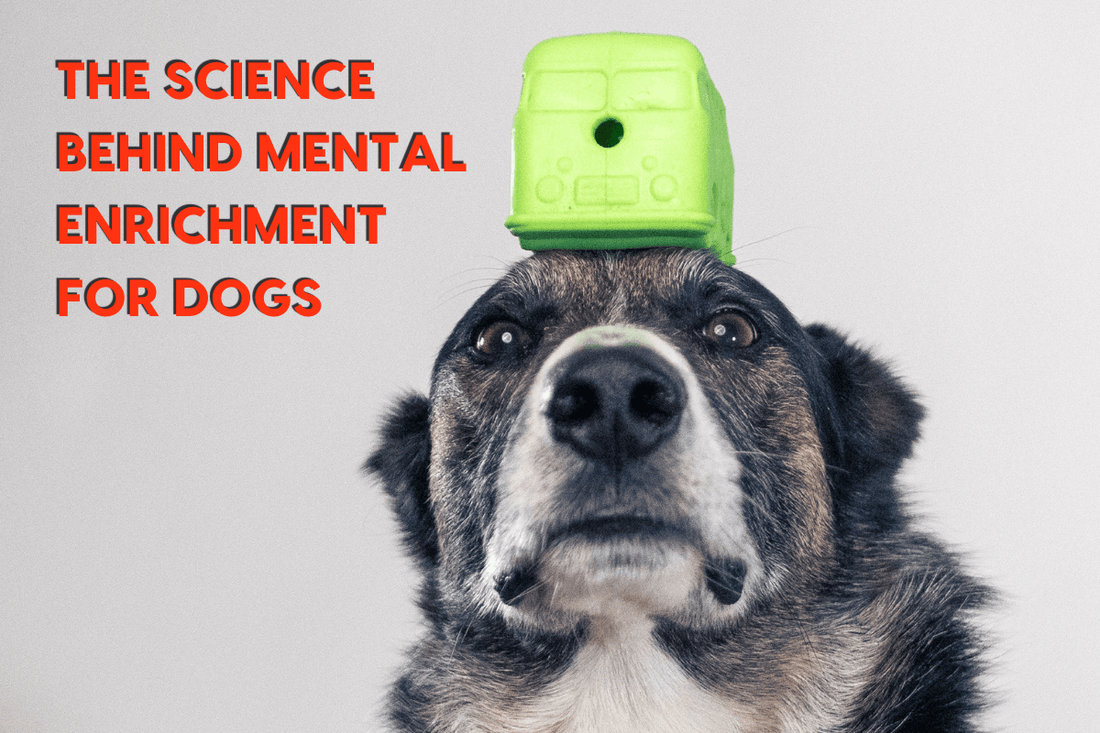The Science Behind Mental Enrichment for Dogs
“Mental enrichment” might sound like a trendy phrase in the dog world, but there’s real, fascinating science behind why it matters so much for your pup’s well-being.
In this post, we’ll break down what research has shown about mental exercise for dogs, and most importantly, we’ll explore why activities like puzzle toys, foraging games, and snuffle mats don’t just entertain your dog, they help build a healthier brain and happier life.
🎧 Want to hear more on this topic? Listen to the Perfect Pup Podcast episode linked here.
🎥 Prefer to watch? You can also catch the video version on our site.
What the Research Says About Mental Enrichment
In Schipper’s 2008 study, researchers observed eight shelter dogs and introduced them to a simple enrichment tool: a food-stuffed Kong. By comparing the dogs’ behavior before, during, and after the enrichment sessions, they were able to track changes in activity levels and emotional expression.
Here’s what they found:
“The presence of food enrichment toys stimulates appetitive behaviors and increases the level of activity, measured in time budgets and the total number of behavioral transitions. Moreover, it also appears to result in lower barking frequencies.”
In other words, just giving the dogs a Kong filled with treats led to:
- More appetitive behaviors (sniffing, searching, foraging, and working for food)
- Increased activity levels (healthier, more natural movement)
- Decreased barking (a sign of reduced frustration or stress)
That’s an incredible outcome from something as simple as a toy filled with food.
What’s Happening in the Brain During Enrichment?
When your dog engages in foraging, sniffing, or problem-solving activities, several key things are happening inside their brain:
🧠 Dopamine Release
When a dog works to solve a puzzle or uncover hidden treats, their brain releases dopamine, the “feel-good” neurotransmitter. This is the same brain chemical responsible for pleasure and motivation. By giving your dog opportunities to “earn” rewards through enrichment, you’re literally boosting their mood chemistry.
🔍 Cognitive Activation
Mental enrichment stimulates the prefrontal cortex, the part of the brain involved in decision-making, impulse control, and focus. When dogs engage their minds regularly, they strengthen these neural pathways, just like muscle building through exercise. This is why mentally stimulated dogs tend to be calmer, more adaptable, and more capable of learning new behaviors.
❤️ Stress Reduction
Studies have shown that engaging in enrichment activities can lower cortisol (the stress hormone) in dogs. The act of sniffing, central to most enrichment tasks, has a particularly calming effect on the canine nervous system. In fact, “nose work” has been shown to regulate heart rate and promote relaxation.
Why Mental Enrichment Is Especially Important for Shelter Dogs
The original study focused on shelter dogs for good reason. Dogs in kennel environments often experience reduced stimulation, frustration, and even signs of depression. Over time, this can lead to repetitive or stress-induced behaviors like excessive barking, pacing, or chewing.
By introducing enrichment, the researchers helped replace stress-driven habits with purposeful behaviors like searching and problem-solving, behaviors that are part of a dog’s natural repertoire.
Even though this study was small and preliminary, it reinforced a key point: mental enrichment doesn’t just entertain dogs, it can restore their behavioral balance and emotional health.
Bringing Enrichment Science Home
The science behind enrichment isn’t limited to shelters, it applies to every dog, in every home.
When you engage your pup’s brain daily, you’re doing more than just keeping them occupied. You’re:
- Supporting cognitive development and problem-solving skills
- Providing an outlet for natural instincts like foraging and hunting
- Reducing stress and anxiety
- Encouraging calmer behavior and less frustration-driven barking
- Building a stronger bond between you and your dog
Even just 10–15 minutes of focused mental work can have measurable effects on your dog’s behavior and mood.
Simple Ways to Add Enrichment to Your Dog’s Day
Here are some scientifically backed enrichment ideas to try at home:
Food-Dispensing Toys:
Kongs, SodaPup toys, or other puzzle feeders that make your dog work for their food.
Snuffle Mats:
These activate the nose and brain, mimicking the natural foraging behavior that triggers dopamine release.
Foraging Boxes:
Hide treats inside layers of cardboard boxes or crumpled paper for your pup to discover.
Lick Mats:
Great for calming anxious dogs and promoting focus.
Training Games:
Trick training, nose work, or hide-and-seek all count as mental enrichment.
Consistency is key, incorporating at least one form of mental enrichment into your dog’s daily routine can dramatically improve their emotional health and reduce unwanted behaviors.
The Takeaway
The science is clear: mental enrichment changes your dog’s brain for the better.
It boosts mood, encourages healthy activity, reduces stress behaviors like barking, and helps dogs, especially those in confined or low-stimulation environments, reconnect with their natural instincts.
So next time you fill a Kong or sprinkle treats into a snuffle mat, remember, you’re not just entertaining your pup. You’re strengthening their mind, improving their wellbeing, and deepening your bond through science-backed enrichment.
📚 Further Reading:









